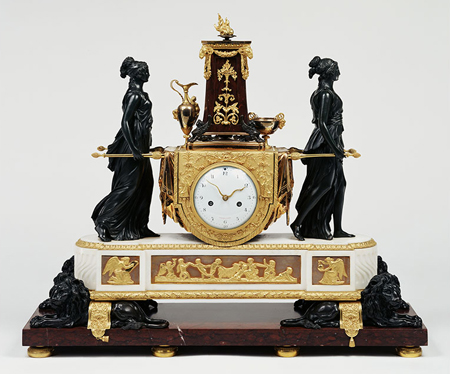Getty Acquires Rare Gilt-Bronze Pieces
 Mantel Clock, about 1789. Clock case attributed to Pierre-Philippe Thomire.
Mantel Clock, about 1789. Clock case attributed to Pierre-Philippe Thomire.Photograph courtesy of the J. Paul Getty Museum.
The Los Angeles based The J. Paul Getty Museum announced the recent acquisition of an important collection of 18th century French decorative arts assembled by Dr. Horace Wood (Woody) Brock, one of the world’s foremost economists.
The acquisition includes 31 works of art, including seven clocks; six gilt-bronze mounted porcelain, feldspar and porphyry objects; five works in gilt bronze including a pair of candelabra, two sets of firedogs, and two sets of decorative vases; a carved gilt-wood console table; a porcelain inkstand; and a leather portrait medallion of Louis XIV. The collection substantially enhances the Getty Museum’s extraordinary holdings of French decorative arts, renowned as one of the most important outside France.
Highlights of the new collection include a pair of gilt-bronze candelabra, attributed to the prominent Baroque cabinetmaker André-Charles Boulle who was called “the most skillful artisan in Paris.” Two early Rococo lidded jars include exotic motifs from the Far East; porcelain and hardstones were avidly collected and prominently displayed, mounted with gilt bronze to highlight the beauty and rarity of porphyry and feldspar.
“These exquisite objects constitute the most significant acquisition of French decorative arts made by the Museum in many years,” said Timothy Potts, director of the J. Paul Getty Museum. “Produced in the sophisticated artistic culture of eighteenth-century Paris, these extraordinary works epitomize the skill and artistry that made the French court and aristocratic life the epitome of elegant extravagance, and the envy of collectors throughout Europe. We are deeply grateful to Dr. Brock for his generosity in enriching our collection with this important gift and purchase.”
Dr. Brock has been collecting French and English decorative arts and Old Master drawings for the last thirty years. He began lending decorative arts objects to the Getty Museum in 1997 and made several long-term loans through 2008. Since being lent to the Getty, these objects have been on continuous display in the European decorative arts galleries in the South Pavilion Plaza Level at the Getty Center.
The newly-acquired works were created as luxury objects that would have decorated the lavishly furnished residences of the French aristocracy and bourgeoisie. Many, such as the clocks, candelabra, and the inkstand, were made for practical use, but their sophisticated design and rare materials were also meant to demonstrate the wealth, prestige, and refined taste of their owners. The objects represent the full range of decorative styles practiced during the eighteenth century, from the grandeur and opulence of late Baroque and Régence, through the intimate brilliance of the Rococo, to the severe restraint of the Neoclassical.
Resources:
Also in this Issue:
- Sonia and Sergio Lub: A Family Love Affair with Copper
- Hand Stamped Copper Cards And Jewelry Express Forever Sentiments
- Getty Acquires Rare Gilt-Bronze Pieces
- Celtic Lure in Bronze
- Continuing America’s Watchmaking Legacy at RGM
